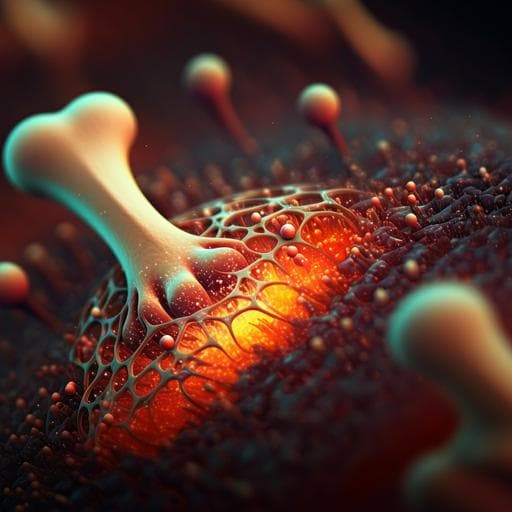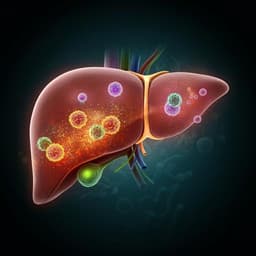
Medicine and Health
RANKL blockade for erosive hand osteoarthritis: a randomized placebo-controlled phase 2a trial
R. Wittoek, G. Verbruggen, et al.
This study by Ruth Wittoek, Gust Verbruggen, Tine Vanhaverbeke, Roos Colman, and Dirk Elewaut explores the impact of denosumab on erosive hand osteoarthritis. Results show significant reductions in radiographic erosive progression and long-term clinical benefits after 96 weeks of treatment. Discover how this RANKL inhibitor could change the game in managing OA.
~3 min • Beginner • English
Introduction
Erosive hand osteoarthritis (OA) of the interphalangeal joints is a common, predominantly female condition characterized by a high disease burden and limited effective disease-modifying therapies. Radiographic features include cartilage loss followed by subchondral bone erosions and eventual remodeling, with erosive and reparative features potentially co-occurring over long disease courses. Evidence links erosive hand OA to systemic bone fragility, with thinner bones preceding disease, greater bone and cartilage loss as it progresses, and histologic evidence of osteoclast-mediated resorption accompanied by elevated bone resorption markers. Denosumab, a fully human monoclonal antibody against RANKL, inhibits osteoclast-driven bone resorption and has delayed erosive progression in rheumatoid arthritis irrespective of inflammatory control. This study aimed to test whether denosumab can slow structural damage progression and prevent new erosive joints in erosive hand OA, focusing on radiographic structure modification as the primary outcome while treating clinical measures as exploratory endpoints.
Literature Review
Prior research indicates that patients who develop erosive hand OA exhibit cortical and trabecular fragility, with increased bone and cartilage loss even in non-OA joints, and histology shows active osteoclast resorption with elevated serum bone resorption markers. In RA, denosumab reduces erosive progression in a dose-dependent manner without clear symptomatic effects, supporting a structure-modifying role. Trials targeting inflammatory pathways in erosive hand OA (e.g., TNF and IL-1 inhibitors) have generally failed to improve structural outcomes. Intra-articular corticosteroids can relieve symptoms and reduce synovitis, and clodronate (a bisphosphonate) showed pain relief and biomarker improvements, but structural changes were not evaluated in short-term studies. The HOPE trial showed short-term symptom improvement with prednisolone in non-erosive hand OA, yet structural outcomes remained unassessed. Emerging concepts propose an ‘osteoporotic endotype’ of OA where cortical fragility contributes to subchondral attrition and erosions, suggesting bone-targeted therapies like RANKL inhibition may be effective for erosive hand OA.
Methodology
Design: Monocentric, randomized, double-blind, placebo-controlled, parallel-group phase 2a clinical trial conducted at Ghent University Hospital, Belgium (EUDRACT 2015-003223-53), adhering to Good Clinical Practice and the Declaration of Helsinki.
Participants: Adults ≥30 years with erosive hand OA defined by at least one interphalangeal (IP) joint in Verbruggen and Veys J (loss of joint space) or E (erosive) phase on radiographs, plus local inflammatory activity clinically (soft tissue swelling) and by ultrasound (effusion and/or synovial proliferation ≥ grade 1). Key exclusions: prior denosumab; recent bisphosphonates/strontium; recent chondroprotectives/DMARDs; vitamin D deficiency; hypo/hypercalcemia; significant comorbidities/cancer/infections; conditions limiting consent/compliance; osteonecrosis of jaw risk or planned invasive dental procedures; transplants; hypersensitivity to study drug; substance abuse; pregnancy/breastfeeding; inflammatory rheumatic diseases.
Randomization and masking: 1:1 allocation to denosumab or placebo using fixed blocks of four; allocation list generated independently. Identical syringes and blinding for patients and investigators, maintained through the open-label extension.
Interventions: Denosumab 60 mg or placebo administered subcutaneously every 12 weeks for 48 weeks (double-blind). All participants received daily oral calcium (1,000 mg elemental) and vitamin D (880 IU). Rescue analgesics/NSAIDs permitted at stable doses for 12 weeks; corticosteroids prohibited. Open-label extension (weeks 48–96): all received denosumab 60 mg every 12 weeks.
Assessments: Radiographs (posteroanterior both hands) at baseline, weeks 24 and 48; all 16 second–fifth distal/proximal IP joints assessed by two experienced rheumatologists, blinded to allocation and clinical data. Structural scoring used: (1) Ghent University Scoring System (GUSS), three subdomains (subchondral bone, subchondral plate, joint space), each 0–100; total 0–300 (higher = less damage/remodeling); (2) Verbruggen and Veys anatomical phase scoring (N, S, J, E, R, F). Reader inter/intra-reliability assessed; consensus used when no absolute agreement.
Ultrasound: Baseline, week 12, week 48 by experienced sonographer; synovial proliferation, effusion, power Doppler (0–3 each), and erosions (present/absent) recorded for PIP and DIP joints 2–5.
Clinical outcomes: Pain NRS (0–10), FIHOA (0–30), AUSCAN (pain 0–50, function 0–90, stiffness 0–10, total 0–150), tender and swollen joint counts, and patient global efficacy NRS (0–10) collected at specified visits. DXA at baseline and week 48 (femoral neck, lumbar spine). Safety: adverse events (AEs/SAEs), discontinuations, labs (e.g., calcium, phosphorus, creatinine, CRP).
Endpoints: Primary efficacy endpoint was change in total GUSS from baseline to week 24 in target joints (baseline J or E phase with clinical and ultrasound inflammation). Secondary endpoints: change in GUSS from baseline to week 48 and percentage of new erosive joints (transition to J/E) among baseline pre-erosive joints (N, S, J) per patient at week 48. Exploratory endpoints included clinical measures (pain, function), ultrasound changes (week 12 synovitis/effusion/PD; week 48 erosions), and percentage changes in BMD at femoral neck and lumbar spine at week 48. Safety endpoints included AE/SAE counts and withdrawals.
Sample size and statistics: Planned n=46 per arm to detect a 20-unit mean GUSS difference at week 24 (SD 29, 90% power, two-sided α=0.05); allowing 8% attrition, 100 patients were enrolled. Primary analysis was intention-to-treat at the joint level using generalized estimating equations (GEE) accounting for within-patient clustering, with robust SEs, exchangeable correlation; covariates included treatment, visit (categorical), treatment×visit interaction, and baseline GUSS. Missing data for the primary endpoint imputed via predefined model (randomization group, baseline and other timepoint values, baseline inflammation, baseline number of affected joints). Secondary/exploratory outcomes analyzed at patient level (except GUSS week 48) using GEE; missing values replaced by baseline observations. Sensitivity analyses: (1) baseline observation carried forward for missing primary endpoint data; (2) three-level linear mixed model with patient and joint random effects and fixed effects for baseline GUSS, treatment, time (weeks 24, 48), and treatment×time. Subgroup analyses included interaction of baseline clinical inflammation (yes/no) with treatment effect and an extended target-joint set (joints progressing to J/E/E-R during study not already J/E at baseline). Open-label extension analyses used similar GEE models with groups defined by initial randomization.
Key Findings
- Enrollment and completion: 136 screened; 100 randomized (51 denosumab, 49 placebo) and treated; 46 per group completed 48 weeks. Baseline characteristics balanced. Inter/intra-reader reliability for radiographic scoring was excellent.
- Primary endpoint (GUSS change at week 24): Baseline-adjusted mean (SEM) GUSS was 162.2 (2.4) with denosumab vs 153.3 (3.2) with placebo; estimated between-group difference 8.9 (95% CI 1.0 to 16.9; P=0.024).
- Secondary structural outcomes:
- GUSS at week 48: 163.5 (2.9) denosumab vs 149.2 (3.9) placebo; difference 14.3 (95% CI 4.6 to 24.0; P=0.003).
- New erosive joints through week 48: 9/501 (1.8%) with denosumab vs 38/535 (7.0%) with placebo; estimated OR for erosive progression 0.24 (95% CI 0.08 to 0.72; P=0.009). Some new erosions in denosumab at week 24 resolved by week 48.
- Exploratory clinical outcomes (weeks 24 and 48): No significant between-group differences in pain NRS, FIHOA, AUSCAN, tender/swollen joint counts, or patient global efficacy (all P>0.05; see Extended Data Table 2). Analgesic/NSAID use was low; patterns differed over time between groups.
- Ultrasound and BMD: Synovitis and effusion decreased in both groups at weeks 12 and 48; ultrasound erosion score reduced significantly with denosumab at week 48 vs baseline, not in placebo (between-group P=0.007). Percentage change in femoral neck BMD at week 48 favored denosumab by 2.8 percentage points (P<0.001); lumbar spine differences were not significant in the tabled analysis.
- Safety (through week 48): AEs were more frequent with placebo (125 events in 44 patients, 90%) than denosumab (97 events in 41 patients, 80%). SAEs: 7 placebo vs 6 denosumab. Discontinuations due to AEs: 3 in each group. Cancer occurred in 3 placebo patients; none in denosumab. Asymptomatic hypocalcemia occurred in 5 (10%) denosumab vs 3 (6%) placebo.
- Sensitivity analyses: Baseline-observation imputation confirmed primary results at weeks 24 and 48. Three-level mixed model showed significant between-group change to week 48 (difference 13.9; 95% CI 4.1 to 23.7; P=0.007) but not at week 24.
- Subgroups: No significant interaction between baseline clinical inflammation and treatment effect on GUSS at weeks 24 or 48. Extended target-joint analysis favored denosumab at weeks 24 (difference 11.8; 95% CI 3.6 to 20.0; P=0.004) and 48 (difference 19.7; 95% CI 9.4 to 29.9; P<0.001).
- Extension phase (post-hoc, weeks 48–96): Continued structural improvement in both groups after all received denosumab; larger GUSS increase from week 48 to 96 in the former placebo group (25.7 vs 9.9; P=0.035). At week 96, pain NRS favored the original denosumab group (difference −1.0; 95% CI −1.8 to −0.2; P=0.018) and FIHOA favored original denosumab (difference −1.7; 95% CI −3.3 to −0.1; P=0.04).
Discussion
The trial demonstrates that RANKL inhibition with denosumab reduces structural progression in erosive hand OA within 24 weeks, with greater effects by 48 weeks, and substantially lowers the risk of developing new erosive joints. These radiographic improvements support the hypothesis that osteoclast-mediated bone resorption is central to erosive hand OA pathogenesis and align with the concept of an osteoporotic endotype. Clinical symptoms did not differ significantly in the first 48 weeks, consistent with expectations that structural modification may precede symptomatic benefit. However, the open-label extension suggests that sustained denosumab therapy can translate into clinically meaningful reductions in pain and disability by 96 weeks. Safety findings were comparable to prior denosumab use in other conditions, with no new signals despite a higher-than-osteoporosis dosing interval, and overall AE incidence was higher with placebo. Collectively, these results advocate a shift in erosive hand OA management toward preventing structural damage to achieve longer-term clinical benefits.
Conclusion
Denosumab 60 mg subcutaneously every 12 weeks significantly slowed radiographic progression and reduced incident erosive joints over 48 weeks in erosive hand OA, establishing proof-of-concept for targeted structure modification in this disease. Prolonged treatment was associated with later improvements in pain and function. These findings open therapeutic avenues focused on bone resorption pathways for erosive hand OA. Future research should assess long-term durability, outcomes after treatment cessation (including potential rebound in bone turnover), effects on bone quality, mechanisms and cellular sources of RANKL in this disease, and confirm efficacy and safety in larger, multicenter phase 3 trials with stratified patient populations.
Limitations
- Generalizability: Inclusion required inflammatory signs and J/E phase joints, enriching for a specific subset and potentially limiting applicability to broader hand OA populations without active inflammation.
- Monocentric design: Single-center setting may limit external validity; larger multicenter studies are needed.
- Clinical outcomes: No short-term symptomatic benefits were observed within 48 weeks; clinical improvements emerged only after longer-term treatment in post-hoc extension analyses.
- Safety uncertainties: Long-term safety and effects of denosumab discontinuation (e.g., rebound in bone turnover noted in osteoporosis) remain to be clarified in this population.
- Heterogeneity and stratification: Hand OA heterogeneity suggests the need for stratified approaches to identify responders.
- Potential influence of concomitant analgesics/NSAIDs on clinical endpoints and the global, non-joint-specific nature of some patient-reported measures may have limited sensitivity to change.
Related Publications
Explore these studies to deepen your understanding of the subject.







